When I told my coach that I will be running a marathon in the spring and then 5 months later doing an Ironman, she cringed. My initial thought was: isn’t it a great idea to run the whole distance in training, since you will be beat after swim and bike? So I thought I’d look into it. I will be talking about the triathlon training a lot, but I will address single sport events, too.
Swimming
Open water swimming races are quite an experience… All the crowds around you, the kicking, the sighting, the unpredictable conditions… Believe it or not, but these are factors in how far you have to swim in training.
There isn’t terribly much out there on the subject, but there are a few pieces of advice I saw that I saw in my IM70.3 training plan and it has come up in my open water experiences, as well as those of my friends and family.
First of all: swimming is a low impact sport, so you don’t need to worry about the damage it causes to your body, like you have to with running. This means you can swim as much as you want. You just have to extend the distance carefully (see my post on adding distance here). Your muscle will need a couple of days in between long practices, but it’s nothing like weeks it takes to recover from a marathon.
So now you know it’s ok to swim the distance you will face during the race and you should do it. But that’s not all to keep in mind! Something I thought I was immune to, but I did encounter during my IM70.3:

Yes, I’m talking about comfort in the water and panic. It’s more important for you to gain comfort in the water than to work on the distance actually. I am great in the pool, but as it turned out, I am not immune to doubts in the cold sea. You may also have to deal with a wet suit, which is a whole another problem. It’s best to swim as much as you can in one if your race will call for one – your body tires differently in one.
Let’s get back to the actual distance. If you are swimming in the pool, you are always going in a straight line. Do you know why that’s an issue? Because in the open water, you may be dodging other people, fighting currents and struggling to keep a straight line (it’s not as easy when you don’t have the dark line on the bottom of the pool to guide you as you may think).
I know this one is from Halloween, but what if this happens to you when you have problems with sighting:

So the actual answer is: a bit more than what the race distance actually is. For a full Ironman, swim portion is 3.8km (2.4 miles). If you are training in a pool, try swimming 4km to get your body used to being in the water that long. Personally, I would recommend doing some extra in the open water, too. You don’t know what obstacles you will be facing on the race day.
Biking
I usually focus on swimming and biking as part of a triathlon, but cycling is a nice sport in its own right with plenty of athletes. There is plenty of people for whom it is their primary focus, so I think it’s a good idea to address endurance training on a bike from both perspective: on its own and as a part of a triathlon. I have used a century ride (100 miles) as a long distance cycling event, since I feel it’s the best approximation of a marathon runners and it’s also the closest common distance to the ride as part of an iron distance triathlon.
Like swimming, biking is also a low-impact sport, so there isn’t as much recovery penalty for distances as there is with running. On the other hand, cycling is the longest part of a triathlon, both distance- and time-wise and it comes with some unique considerations. Most runners and swimmers will assume that the greatest concern is your muscle and endurance when preparing for a long race. However, when it comes to cycling, I have found that it’s actually keeping your butt on the saddle for 6 – 8 hours (or however long it will take you) that hurts a lot. Biking also keeps you in a rather awkward position for hours at a time. In my search for advice on how far should I ride, I saw probably more advice on making sure your back and neck will be ok than on actual distance for your training. I actually already wrote a post on this issue here. So cycling focuses on your body being able to survive the long hours sitting on a bike.

Having said that, recommendations for training distance do exist. For ‘just’ a century ride (a single-sport event), you should complete at least a 70-75 mile ride beforehand. For a 140.6 triathlon, I saw advice going as low as 85 miles. I would call those the bare minimum rides. Since you won’t be dealing with sighting issues like in an open water swim, you don’t need to practice for extra distance, but there is no reason to go the entire 100 miles (for the century ride) or 112 miles (for 140.6 triathlon). I suspect that if your goal is to finish just one century ride, without specific time in mind, you don’t need to hit that distance consistently for a week after week. However, during a triathlon, you will already be ‘pre-fatigued’ (still one of my favorite terms LOL) from swimming and will have to be in good enough shape to make it through a marathon (please note: I am not calling it ‘run’, but 26.2 miles is really far to go on foot). This calls for some level of comfort with the distance. Advice from Beginner Triathlete Blog suggests going 93-112 miles (numbers seem awkward due to unit conversion from the metric system) 10-12 times before the race. This actually seems like a wise piece of advice to me and I think I will be following it. Or at least I will start the 7 hour bike rides on my stationary bike during winter months.
Running
Have you already noticed that the distance you need to complete in training relative to the race distance have been dropping? If so, you won’t be surprised to hear that you run even less when preparing for a marathon.
Marathon and Ironman marathon are their own beasts, so I think it’s a good idea to back up a bit. Majority of people doesn’t plan on running that far. Nevertheless, if you are planning on running in a race/ event, you still need to decide how far to go when training. For your regular 5km and 10km races, it’s easy: just go the distance! It gets more complicated after that though.
When you are planning on racing in a half marathon, there is a couple of questions you need to answer before getting an answer on how far you want to go. The main one, I guess, is if you are going after specific time or do you just want to arrive at the finish line. Because those are two very different events. Based on my various readings over the years and beginning training plans I have seen, you can get away with the longest run of 10 miles. Mind you: it won’t feel awesome and you will be sore afterwards, but you should be able to get your finisher’s medal at the end. I also always think of the 10% rule, which suggests your longest run should be closer to 12 miles. If your plans are more advanced (say: half-marathon under 2 hours), you probably should train a bit more. However, for experienced runners trying to make specific times, I have seen plans going as long as 15 miles.
Off to the big kahuna: the marathon. Here is where we hit the real limitations due to necessary recovery. From my own experience I can tell you that it takes at least a good week to fully recover from 26.2 miles.

Doing this just for training probably isn’t the wisest choice. The one training plan that recommends it is Jeff Galloway. His followers are the groups you will see in the marathon running for a few minutes and then take a walking break. I remember them passing me during the Disney World Marathon. It was a bit funny because they were doing it multiple times. Our average pace was similar, so I would pass them when they were walking and then they would pass me when they would start walking. It was weird! Personally, I am not sold on that method, since I love running at an even pace, but who am I to argue with a professional whose method has worked for many. Jeff Galloway aside, majority of training plans cap at 20 miles. Even ultramarathon training doesn’t seem to advise individual runs much longer than that.
And the key jewel: marathon at the end of an ironman, which is where my inspiration for this post started in the first place. It’s not that easy to find specific advice as to how far is too far to run in training for a long triathlon. I finally found an article on Training Peaks, which said that a triathlete-in-training should do at least 4 runs of 18 miles in preparation for their big day, but limit running training otherwise. I can definitely see how limiting damage to your body done by running would be helpful. After all, you don’t want to slow down your overall progress. They had another piece of useful advice though: work on running right off the bike, so you are prepared for that transition. I guess it’s time for me to start working on those!
